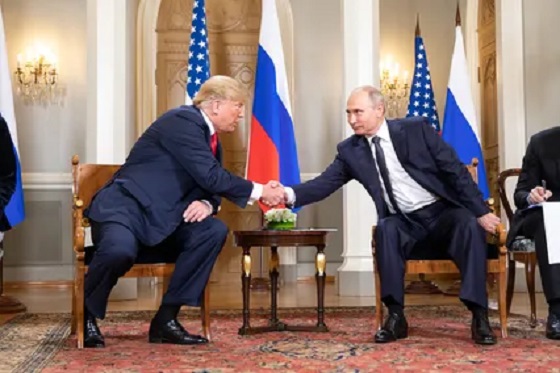conflict
Ukraine War may see breakthrough as Trump sets up Monday Morning call with Putin

 MxM News
MxM News
Quick Hit:
President Trump says he’ll speak with Vladimir Putin by phone Monday at 10 a.m. to stop the Ukraine “bloodbath,” calling for a ceasefire and an end to a war he says “should have never happened.”
Key Details:
-
On Saturday, Trump revealed his plans in a Truth Social post, writing: “THE SUBJECTS OF THE CALL WILL BE, STOPPING THE ‘BLOODBATH’ THAT IS KILLING, ON AVERAGE, MORE THAN 5000 RUSSIAN AND UKRAINIAN SOLDIERS A WEEK.”
-
Trump added that he also intends to reach out to Ukrainian President Volodymyr Zelensky and NATO leaders. “HOPEFULLY IT WILL BE A PRODUCTIVE DAY.”
-
Secretary of State Marco Rubio held a round of discussions with Ukrainian and Russian delegations Thursday in Turkey, followed by a Saturday phone call with Russian Foreign Minister Sergey Lavrov. The talks produced an agreement for a 1,000-for-1,000 prisoner exchange.
— Rapid Response 47 (@RapidResponse47) May 17, 2025
Diving Deeper:
President Trump said Saturday he will hold a direct call with Vladimir Putin on Monday in an attempt to broker a cease-fire in Ukraine, which he described as a “very violent war” that “should have never happened.” His announcement came amid renewed international attention on negotiations after Putin refused to personally attend this week’s summit in Istanbul, opting instead to send a lower-level delegation led by former cultural minister Vladimir Medinsky.
Ukrainian President Volodymyr Zelensky, who had hoped to meet Putin face-to-face, publicly criticized the move. “Russia once again demonstrated that it does not intend to end the war,” Zelensky said Thursday on X. “Such a Russian approach is a sign of disrespect—toward the world and all partners.”
As Kyiv pushes for a 30-day cease-fire, the Kremlin has made clear it wants Ukrainian forces to withdraw from Russian-occupied regions including Donetsk, Luhansk, Zaporizhzhia, and Kherson. Despite these tensions, Secretary of State Marco Rubio, acting on Trump’s behalf, managed to secure an agreement for a prisoner swap during Thursday’s talks. “President Trump’s call for an immediate ceasefire and an end to the violence” was the focus of follow-up communications, according to State Department spokeswoman Tammy Bruce.
Trump told Fox News host Bret Baier on Friday that Zelensky had “pissed away” billions of dollars in U.S. aid, while expressing optimism about halting the war. “We inherited this mess, but I think it’s going to get solved,” Trump said. “I think we’ll do it fast,” adding that Putin “is tired of this whole thing. He’s not looking good, and he wants to look good.”
In his Truth Social post, Trump emphasized both humanitarian and strategic goals for the Monday conversation. Alongside his effort to halt the fighting, Trump said trade would also be discussed during the 10:00 a.m. call with Putin. He reiterated his desire to quickly bring the conflict to an end and restore stability, ending: “GOD BLESS US ALL!!!”
Artificial Intelligence
AI Drone ‘Swarms’ Unleashed On Ukraine Battlefields, Marking New Era Of Warfare


From the Daily Caller News Foundation
Artificial intelligence-powered drones are making their first appearances on the battlefield in the Russia-Ukraine war as warfare creeps closer to full automation.
In bombardments on Russian targets in the past year, Ukrainian drones acting in concert were able to independently determine where to strike without human input.
It’s the first battlefield use of AI “swarm” technology in a real-world environment, a senior Ukrainian official and Swarmer, the company who makes the software, told the Wall Street Journal in a Tuesday report. While drones have increasingly defined modern battlefields, swarms until now had been confined to testing rather than combat.
“You set the target and the drones do the rest,” Swarmer Chief Executive Serhii Kupriienko told the WSJ. “They work together, they adapt.”
So far, the Swarmer technology has been used hundreds of times to target Russia assets, but was first used a year ago to lay mines on the front, the Ukrainian official told the WSJ. The software has been tested with up to 25 drones at once, but is usually utilized with only three.
Kupriienko told the WSJ that he was preparing to test up to 100 drones at once with the linking software.
A common arrangement used on the battlefield includes one reconnaissance drone to scout out the target and two explosive drones delivering the payload on target, the official told the WSJ.
While Western nations such as the U.S., France and the United Kingdom are also pursuing drone swarm technology, they have not deployed swarm technology on the battlefield the way Ukraine has, according to the WSJ. Currently, autonomous weapons are not regulated by any international authority or binding agreement, but ethical concerns around the technology has led many to call for increased regulation of weapons like the Swarmer system.
The Ukrainian Ministry of Foreign Affairs did not immediately respond to the Daily Caller News Foundation’s request for comment.
conflict
Trump Pentagon Reportedly Blocking Ukraine From Firing Western Missiles Deep Into Russia


From the Daily Caller News Foundation
The Department of Defense has spent months blocking the Ukrainian military from using American and British-made missiles to hit targets deep inside Russia, The Wall Street Journal reported Sunday, citing unnamed U.S. officials.
Undersecretary of Defense for Policy Eldridge Colby reportedly designed the procedure to review requests to carry out the long-range strikes with weapons that are either of U.S. origin or that require American intelligence or use components provided by the U.S., according to the WSJ. Secretary of Defense Pete Hegseth reportedly has the final say on whether Ukrainian forces can use the MGM-140 ATACMS (Army Tactical Missile System) to hit targets in Russia.
The reported blocks on missile strikes coincides with a Trump administration effort to broker a peace deal between Russia and Ukraine. A Pentagon spokesperson declined to comment further on the matter.
BREAKING: President Vladimir Putin reacts to B-2 Flyover pic.twitter.com/1mzVn7DxlW
— Jack Poso 🇺🇸 (@JackPosobiec) August 15, 2025
The Biden administration allowed Ukraine to carry out strikes with ATACMS in November, weeks after President Donald Trump won the 2024 election, the New York Times reported. Trump criticized the move during a December interview with Time magazine.
“It’s crazy what’s taking place. It’s crazy,” Trump said. “I disagree very vehemently with sending missiles hundreds of miles into Russia. Why are we doing that? We’re just escalating this war and making it worse. That should not have been allowed to be done.”
Trump and Russian President Vladimir Putin met in Alaska on Aug. 15 for a summit meeting during which Trump sought to secure a cease-fire in Russia’s war with Ukraine. As Trump greeted Putin, a B-2A Spirit stealth bomber and several fighters carried out a flyover of Elmendorf Air Force Base.
Trump met with Ukrainian President Volodymyr Zelensky and major European leaders on Aug. 18 to update them on the summit.
In July, Trump reached an agreement with NATO where members of the alliance would purchase weapons, including MIM-104 Patriot surface-to-air missiles, and donate them to Ukraine.
-

 Alberta1 day ago
Alberta1 day agoAlberta Sports Hall of Fame Announces Class of 2026 Inductees
-

 Business22 hours ago
Business22 hours agoCanada’s climate agenda hit business hard but barely cut emissions
-

 Business2 days ago
Business2 days agoNew Chevy ad celebrates marriage, raising children
-

 Automotive2 days ago
Automotive2 days agoPower Struggle: Governments start quietly backing away from EV mandates
-

 MAiD1 day ago
MAiD1 day agoFrom Exception to Routine. Why Canada’s State-Assisted Suicide Regime Demands a Human-Rights Review
-

 Alberta2 days ago
Alberta2 days agoThis new Canada–Alberta pipeline agreement will cost you more than you think
-

 Energy2 days ago
Energy2 days agoUnceded is uncertain
-

 Business1 day ago
Business1 day agoIs Carney Falling Into The Same Fiscal Traps As Trudeau?









